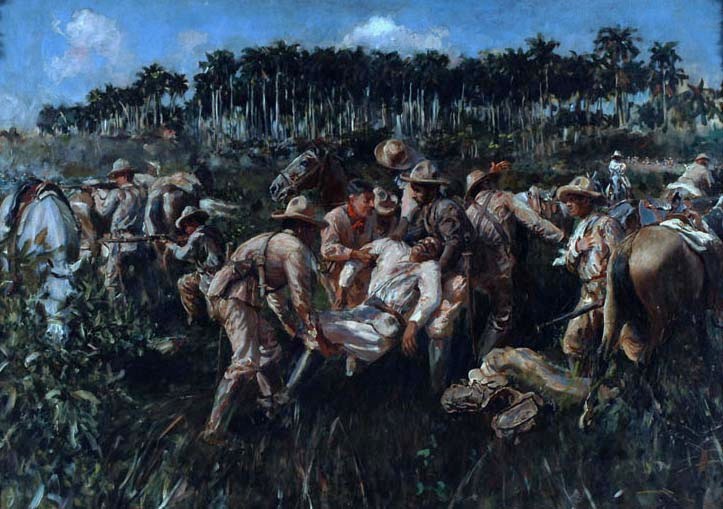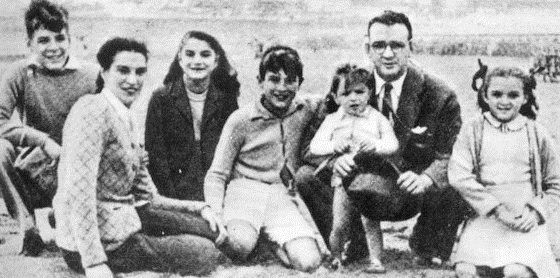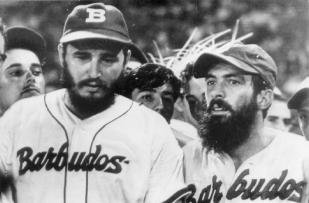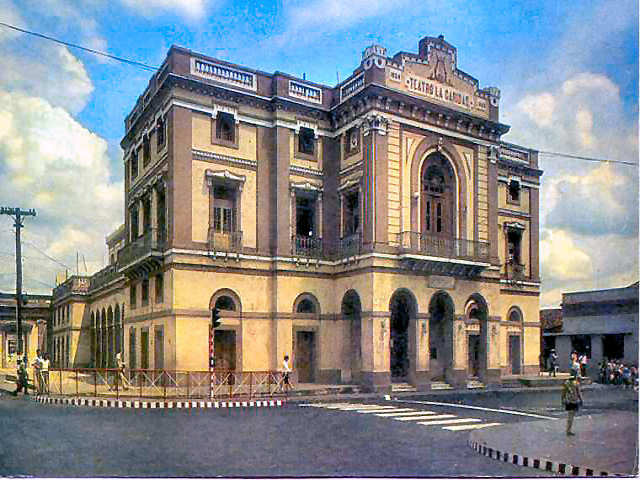|
Parque Vidal
Parque Vidal (also known by its previous names of Plaza Central and Plaza Mayor) is a park located in the center of Santa Clara, Cuba, covering an entire square block of the city. Due to its surrounding architecture, combining eclectic neo-classical and colonial-style buildings, as well as the large number of historic monuments dating from different historical periods, the park was designated as a National Monument in a ceremony in 1998. Monuments in the park The Glorieta gazebo in the center of the park, erected in 1911, still serves for weekly public concerts by the city's Philharmonic Band. North of the Glorieta is a bust of Leoncio Vidal, the War of Independence colonel who died on that spot fighting Spanish forces, and for whom the Park is named. Next to this bust is an obelisk, the first monument erected in the park, dedicated to the priest who migrated from the coastal town of Remedios with other families and founded the city. Between these monuments is a statue of “el ... [...More Info...] [...Related Items...] OR: [Wikipedia] [Google] [Baidu] |
Parque Vidal
Parque Vidal (also known by its previous names of Plaza Central and Plaza Mayor) is a park located in the center of Santa Clara, Cuba, covering an entire square block of the city. Due to its surrounding architecture, combining eclectic neo-classical and colonial-style buildings, as well as the large number of historic monuments dating from different historical periods, the park was designated as a National Monument in a ceremony in 1998. Monuments in the park The Glorieta gazebo in the center of the park, erected in 1911, still serves for weekly public concerts by the city's Philharmonic Band. North of the Glorieta is a bust of Leoncio Vidal, the War of Independence colonel who died on that spot fighting Spanish forces, and for whom the Park is named. Next to this bust is an obelisk, the first monument erected in the park, dedicated to the priest who migrated from the coastal town of Remedios with other families and founded the city. Between these monuments is a statue of “el ... [...More Info...] [...Related Items...] OR: [Wikipedia] [Google] [Baidu] |
Santa Clara, Cuba
Santa Clara is the capital city of the Cuban province of Villa Clara Province, Villa Clara. It is centrally located in the province and Cuba. Santa Clara is the List of cities in Cuba, fifth-most populous Cuban city, with a population of nearly 250,000. History Santa Clara was founded by 175 people on July 15, 1689. 138 of them represented two large families already living in the area, who owned land next to the new city. The other 37 came from seven other families and included a priest and governor, all originating in the coastal city of San Juan de los Remedios. The population of Remedios, Cuba, Remedios had to choose between leaving their city, constantly being besieged by pirates, or staying. While most decided to stay, 37 people traveled south to the interior. On June 1, 1689, they arrived at a hill, joining two other families already present at the site. According to tradition, a mass was celebrated under a tamarind tree and Santa Clara was founded. Since then, the pla ... [...More Info...] [...Related Items...] OR: [Wikipedia] [Google] [Baidu] |
Cuba
Cuba ( , ), officially the Republic of Cuba ( es, República de Cuba, links=no ), is an island country comprising the island of Cuba, as well as Isla de la Juventud and several minor archipelagos. Cuba is located where the northern Caribbean Sea, Gulf of Mexico, and Atlantic Ocean meet. Cuba is located east of the Yucatán Peninsula (Mexico), south of both the American state of Florida and the Bahamas, west of Hispaniola ( Haiti/Dominican Republic), and north of both Jamaica and the Cayman Islands. Havana is the largest city and capital; other major cities include Santiago de Cuba and Camagüey. The official area of the Republic of Cuba is (without the territorial waters) but a total of 350,730 km² (135,418 sq mi) including the exclusive economic zone. Cuba is the second-most populous country in the Caribbean after Haiti, with over 11 million inhabitants. The territory that is now Cuba was inhabited by the Ciboney people from the 4th millennium BC with the Gua ... [...More Info...] [...Related Items...] OR: [Wikipedia] [Google] [Baidu] |
Leoncio Vidal
Leoncio Vidal y Caro (September 12, 1864 – March 23, 1896) was a Cuban revolutionary that fought in the Cuban War of Independence. A colonel, he fell in battle in Santa Clara, Cuba. He is considered a hero in Cuba and the Parque Vidal in Santa Clara was named in his honor. Vidal was the uncle of General Emilio Mola. Early life Born in Cuba to a Cuban mother, Marina del Rosario Caro Reyes, and a Spanish father, Leoncio Vidal Tapia, Vidal and his family lived through the calamities of the Ten Years' War in the town of Corralillo. Vidal's father enlisted in the Spanish forces against the Cuban rebels. However, the killing of a ten-year-old boy drove him to protest the war and move his family to Spain. The Vidal family lived ten years in Barcelona, the birthplace of Leoncio Vidal Tabia. There, Leoncio Vidal y Caro met his extended family, including their paternal grandfather whom awed Leoncio with his stories of resistance against Napoleon's invasion of Spain and the faith in and defen ... [...More Info...] [...Related Items...] OR: [Wikipedia] [Google] [Baidu] |
Cuban War Of Independence
The Cuban War of Independence (), fought from 1895 to 1898, was the last of three liberation wars that Cuba fought against Spain, the other two being the Ten Years' War (1868–1878) and the Little War (1879–1880). The final three months of the conflict escalated to become the Spanish–American War, with United States forces being deployed in Cuba, Puerto Rico, and the Philippine Islands against Spain. Historians disagree as to the extent that United States officials were motivated to intervene for humanitarian reasons but agree that yellow journalism exaggerated atrocities attributed to Spanish forces against Cuban civilians. Background During the years 1879–1888 of the so-called "Rewarding Truce", lasting for 17 years from the end of the Ten Years' War in 1878, there were fundamental social changes in Cuban society. With the abolition of slavery in October 1886, freedmen joined the ranks of farmers and the urban working class. The economy could no longer sustain itse ... [...More Info...] [...Related Items...] OR: [Wikipedia] [Google] [Baidu] |
Remedios, Cuba
Remedios (), also known as San Juan de los Remedios, is a city and municipality located from the northern coast of Cuba, in the center of the island. It is the oldest Spanish settlement in the former Las Villas province. It is now part of the province of Villa Clara. It was declared a City by Isabella II of Spain, when the island was still a colony. Remedios is known as the Cradle of the Parrandas, possibly the Caribbean's largest and oldest traditional festival. Its patrons are John the Baptist and the Virgin of the Buenviaje. Geography Remedios is located about 4 hours by bus from Havana, and around 50 minutes from Santa Clara. It is less than an hour from here to beach resorts in the Santa María – Las Brujas cays, both situated north of the province. The municipality is bordered on the north by Caibarien, to the south by Camajuani and Placetas, and to the east by Yaguajay (formerly known as Sancti Spiritus). Remedios has 10 Consejos Populares which include: Remedios I, ... [...More Info...] [...Related Items...] OR: [Wikipedia] [Google] [Baidu] |
The Boy With The Leaking Boot
''The Boy with the Leaking Boot'' is a statue showing a young boy, with a bare right foot, holding up his right boot and looking at it. The statue is about tall, and in many cases forms a fountain, with water emerging from the toe of the boot. There are at least 24, and reportedly "hundreds" of examples. The origins of the statue are obscure. The boy is reported to be a young Italian newspaper seller who drowned, or an American army drummer-boy who carried water in his leaking boot to help fallen comrades, or a young fire-fighter either using his boot in a bucket chain or emptying his boot after an incident, or possibly none of these. The statue has also been called ''The Boy with the Leaky Boot'', ''Boy Immigrant'' and ''Unfortunate Boot''. Origins The exact origin of the "Boy with the Boot" statue/fountains has been uncertain. It appears the first statues appeared in the U.S. c.1895 and were thought to have been purchased in Europe by wealthy travelers on the "Grand ... [...More Info...] [...Related Items...] OR: [Wikipedia] [Google] [Baidu] |
Marta Abreu
Marta may refer to: People * Marta (given name), a feminine given name * Märta, a feminine given name * Marta (surname) :István Márta composer * Marta (footballer) (born 1986), Brazilian professional footballer Places * Marta (river), an Italian river that flows into the Tyrrhenian Sea * Marta, Lazio, a ''comune'' in Italy * Marta, Nepal, a village development committee Arts and entertainment * ''Marta'' (film), a 1971 Spanish film * "Marta" (Ricardo Arjona song), non-charting * "Marta", a song by Alejandra Guzmán, from the album ''Indeleble'' * "Marta" (Nena Daconte song) a song by Nena Daconte, No.6 in Spain * "Marta, Rambling Rose of the Wildwood", 1931 song by Arthur Tracy * "Marta," a song composed by Moisés Simons MARTA * Metropolitan Atlanta Rapid Transit Authority, the principal rapid-transit system in the Atlanta metropolitan area * Mountain Area Regional Transit Authority, the third largest regional transit agency in San Bernardino County, Califor ... [...More Info...] [...Related Items...] OR: [Wikipedia] [Google] [Baidu] |
Cuban Revolution
The Cuban Revolution ( es, Revolución Cubana) was carried out after the 1952 Cuban coup d'état which placed Fulgencio Batista as head of state and the failed mass strike in opposition that followed. After failing to contest Batista in court, Fidel Castro organized an armed attack on the Cuban military's Moncada Barracks. The rebels were arrested and while in prison formed the 26th of July Movement. After gaining amnesty the M-26-7 rebels organized an expedition from Mexico on the Granma yacht to invade Cuba. In the following years the M-26-7 rebel army would slowly defeat the Cuban army in the countryside, while its urban wing would engage in sabotage and rebel army recruitment. Over time the originally critical and ambivalent Popular Socialist Party would come to support the 26th of July Movement in late 1958. By the time the rebels were to oust Batista the revolution was being driven by the Popular Socialist Party, 26th of July Movement, and the Directorio Revoluci ... [...More Info...] [...Related Items...] OR: [Wikipedia] [Google] [Baidu] |
Che Guevara
Ernesto Che Guevara (; 14 June 1928The date of birth recorded on /upload.wikimedia.org/wikipedia/commons/7/78/Ernesto_Guevara_Acta_de_Nacimiento.jpg his birth certificatewas 14 June 1928, although one tertiary source, (Julia Constenla, quoted by Jon Lee Anderson), asserts that he was actually born on 14 May of that year. Constenla alleges that she was told by Che's mother, Celia de la Serna, that she was already pregnant when she and Ernesto Guevara Lynch were married and that the date on the birth certificate of their son was forged to make it appear that he was born a month later than the actual date to avoid scandal. ( Anderson 1997, pp. 3, 769.) – 9 October 1967) was an Argentine Marxist revolutionary. A major figure of the Cuban Revolution, his stylized visage has become a ubiquitous countercultural symbol of rebellion and global insignia in popular culture. As a young medical student, Guevara traveled throughout South America and was radicalized by the poverty, hunger, ... [...More Info...] [...Related Items...] OR: [Wikipedia] [Google] [Baidu] |
Camilo Cienfuegos
Camilo Cienfuegos Gorriarán (; 6 February 1932 – 28 October 1959) was a Cuban revolutionary born in Havana. Along with Che Guevara, Fidel Castro, Juan Almeida Bosque, and Raúl Castro, he was a member of the 1956 ''Granma (yacht), Granma'' expedition, which launched Fidel Castro's armed insurgency against the government of Cuban dictator Fulgencio Batista. He became one of Castro's top guerrilla commanders, known as the "Battle of Yaguajay, Hero of Yaguajay" after winning a key battle of the Cuban Revolution. His signature weapons were a Thompson submachine gun, M1921AC Thompson and a modified M1 carbine, M2 carbine. He was appointed head of Cuba's armed forces shortly after the victory of Castro's rebel army in 1959. He was presumed dead when a small plane he was traveling in disappeared during a night flight from Camagüey to Havana later that year. Many have speculated and conspiracies have arisen concerning his mysterious disappearance. Cienfuegos, whose name translates ... [...More Info...] [...Related Items...] OR: [Wikipedia] [Google] [Baidu] |
Teatro De La Caridad
Teatro de La Caridad or Teatro La Caridad (Spanish for "Charity's Theater"), located in Santa Clara, is one of the few remaining colonial theatres in Cuba. It is a National Monument of Cuba. History Early history Teatro de La Caridad was built in 1885 and is one of The Eight Grand Theaters of Cuban Colonial era along with Teatro de la Marina in Santiago de Cuba 823 Milanes in Pinar del Río 838 Tacón in Havana 838 Brunet in Trinidad, Cuba">Trinidad [1840], Principal in Camagüey [1850], Sauto in Matanzas [1863] and Terry in Cienfuegos [1890]. The theater was financed entirely by Marta Abreu, Marta Abreu de Estevez, a local and beloved philanthropist who contributed to the prosperity of the city, donating resources to many other projects. La Caridad is one of her greatest legacies. Engineer Don Herminio Leiva y Aguilera was in charge of the design of the building. Asked for more functionality Don Herminio came up with a structure with an auditorium for 500+ observers, a mi ... [...More Info...] [...Related Items...] OR: [Wikipedia] [Google] [Baidu] |






